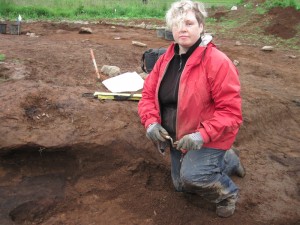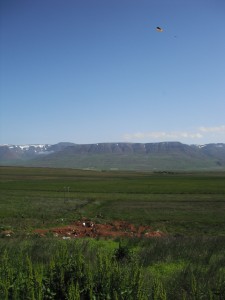Julie, Eric, and I spent most of today at Stóra-Seyla clearing, photographing, and beginning to excavate several grave cuts to the north of the church.
Julie and I put our heads together and got the pole camera running. We got several good, clear shots of the cleaned grave cuts. The outlines of the graves – where the gravediggers cut through the earth to bury their dead in 11th century Stóra-Seyla – are extremely clear now that we have opened the area down to the level of the landnám tephra. The contrast between the dark-colored tephra and the lighter brown, mottled grave fill makes the interface stand out. These cuts in the tephra are also visible in the ground-penetrating radar results from our 2009 survey.
This photo, with southeast at the top, shows the area where we were working. At left are two possibly connected graves that I began to clear just after the photo was taken. Eric traced the outlines of the two connected cuts that show most clearly at center, while Julie worked in the small area at right, in shadow.
With lots of guidance from Guðný, the director of archaeology at the museum who has been excavating cemeteries in Skagafjörður for many years, we began to (carefully) excavate.
Julie’s area soon began to reveal the very small bones of an infant. This newborn had been carefully placed in the small grave very close to the church with its head resting on a pillow of H3 tephra (the lighter soil under the skull in the photo). (Much like the landnám layer in the pole photos, H3 also covers the entire site, but at a depth below the landnám.)
The northernmost of my two cuts revealed a skull late in the afternoon, probably that of a young woman. Women were usually interred to the north of the church, and men to the south.
We don’t yet know whether Eric’s area contains human remains. Many of the people buried here were disinterred during the late Viking Age and reburied elsewhere, meaning that many of the graves we are excavating contain only fill. We hope to learn more tomorrow.
Meanwhile, John was flying the kite overhead whenever the the winds were right!






